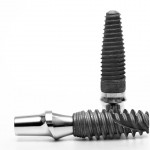
Dental implants are increasingly being used to replace missing teeth in contrast to the more traditional use of bridges or dentures. Implants have been used since the 1970s with the recommendation that they were kept load –free during the healing period (3-4months for the mandible, 6-8 months for the maxilla) . Since the 1990s studies have been published indicating that immediate loading was possible. The aim of this updated Cochrane review was to evaluate the effects of immediate (within 1 week), early (between 1 week and 2 months), and conventional (after 2 months) loading of osseointegrated implants.
The review followed standard Cochrane protocols with searches of the Cochrane Oral Health Group’s Trials Register, the Cochrane Central Register of Controlled Trials (CENTRAL) Medline and Embase databases with no restrictions. Authors of identified trials were contacted to identify any unpublished studies and we checked the bibliographies of all identified RCTs and relevant review articles. Randomised controlled trials (RCTs) of root-form implants with a follow-up of 4 months to 1 year after loading were included. The outcome measures were prosthesis and implant failures and radiographic marginal bone level changes.
- 26 trials including a total of 1217 participants and 2120 implants were included.
- 3 trials were at low risk of bias, 12 at high risk and for the remaining 11 the risk of bias was unclear.
- In 9 studies there were no prosthetic failures within the first year, with no implant failures in 7 studies
- The mean rate of implant failure in all 26 trials was a low 2.5%.
- From 15 RCTs comparing immediate with conventional loading there was no evidence of a difference in either: –
- prosthesis failure (RR 1.87; 95% CI 0.70 to 5.01; 8 trials) or
- implant failure (RR 1.65; 95% CI 0.68 to 3.98; 10 trials) in the first year,
- There is some evidence of a small reduction in bone loss favouring immediate loading. However, this very small difference may not be clinically important.
- From 3 RCTs comparing early loading with conventional loading, there is insufficient evidence to determine whether or not there is a clinically important difference in prosthesis failure, implant failure or bone loss.
- 6 RCTs compared immediate and early loading and found insufficient evidence to determine whether or not there is a clinically important difference in prosthesis failure, implant failure or bone loss.
- From the2 trials which compared occlusal loading with non-occlusal loading there is insufficient evidence to determine whether there is a clinically important difference in the outcomes of prosthesis failure, implant failure or bone loss.
- No trials were identified that evaluated progressive loading of implants.
The authors concluded
Overall there was no convincing evidence of a clinically important difference in prosthesis failure, implant failure, or bone loss associated with different loading times of implants. More well-designed RCTs are needed and should be reported according to the CONSORT guidelines
Comment
As the authors note in their discussion the question of early loading has important benefits to patients and clinicians. Also the authors note that this update did not provide much new information as many of the trials published since the last update in 2009 had to be excluded. They have also expressed some concern regarding the voracity of the reporting of these trials highlighting the need to use international standards as recommended by CONSORT.
Links
Esposito M, Grusovin MG, Maghaireh H, Worthington HV. Interventions for replacing missing teeth: different times for loading dental implants. Cochrane Database of Systematic Reviews 2013, Issue 3. Art. No.: CD003878. DOI: 10.1002/14651858.CD003878.pub5.

[…] Dental Elf 10th April 2013 :- No convincing evidence of a clinically important difference with diffe… […]
[…] Dental Elf – 10th Apr 2013 – No convincing evidence of a clinically important difference wit… […]